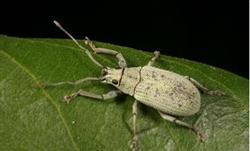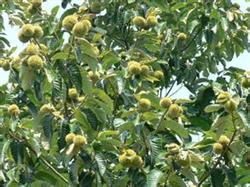Green manure pressing technology of Chinese chestnut in rainy season

Pressing green manure under chestnut trees can improve soil and prevent soil erosion. It has many advantages, such as low investment, low cost, high comprehensive utilization rate and so on. In this paper, the green manure technology of Chinese chestnut in rainy season is introduced as follows: 1. The source of chestnut green manure. One is artificial cultivation of green manure, commonly used are Amorpha, mung beans and other leguminous plants; the other is wild green manure, such as weeds, leaves, fresh shrubs and so on. two。 The method of applying green manure to Chinese chestnut. (1) timely harvesting or turning. The yield of green manure is low, the plant is too young, the decomposition is too fast after green pressing, and the fertilizer effect is short; too late, the green manure plant is aging, most nutrients are transferred to the seeds, the nutrient content of stems and leaves is low, and the ratio of carbon to nitrogen in stems and leaves is high, so it is not easy to decompose in the soil and reduce fertilizer efficiency. In general, the suitable turning time for legume green manure plants is from full flowering to flowering stage, Gramineae green manure plants should be turned at heading stage, and cruciferous green manure plants should be turned at the upper flowering stage and pod stage. (2) overturning method. Digging ring or strip ditches outside the crown, the width and depth of the ditch are both 30cm to 40cm, the sandy soil can be deeper, the clay soil can be shallower, the ditch length is the same as one side of the canopy, and the green manure and soil layer by layer are pressed into the ditch. When turning and pressing, it is necessary to be buried and compacted, so that the green manure and the soil are close and without pores. Using fresh material to cover the tree plate or put it in the tree row as fertilizer can play a certain role in preserving soil moisture under the tree. (3) the application amount of green manure. It should depend on the type of green manure, climate characteristics, soil fertility and crop nutrient needs. Generally, the application of 1000-1500 kg fresh seedlings per mu can basically meet the needs of crops, and 1-2 kg of calcium superphosphate is mixed into every 100 kg of green manure to adjust the relative balance of nitrogen, phosphorus and potassium. (4) Comprehensive utilization of green manure. The stems and leaves of leguminous green manure are good fodder for livestock, in which nitrogen 1ram 4 is absorbed and utilized by livestock, and the other nitrogen is excreted through feces and urine to become a good barnyard manure. (3) commonly used green manure crops suitable for artificial planting. Amorpha fruticosa. Intercropping in chestnut orchard, sowing in spring, seed consumption of 1-2kg per mu, can also be pressed in spring. If the harvest is 2 to 3 times a year for more than 2 years, 1000 to 2000 kg of fresh material can be harvested per mu. Amorpha has strong adaptability, drought tolerance, waterlogging tolerance, salt tolerance, hillside, Weir land, gully can be planted. Once planted for many years, the branches and leaves are easy to rot and the fertilizer efficiency is high. Mung beans. Sow seeds in spring and summer, using 2 kilograms per mu. 60 days after sowing, the harvest is in full bloom, and the fresh material can be harvested at 1000kg to 1500kg per mu. Sowing in the same year and harvest in the same year, it grows fast, has a high yield and is perishable. Like high temperature, drought, barren, not waterlogging. Acid soil or saline-alkali soil can be planted. Alfalfa. The seeds can be sown in spring, autumn and summer, harvesting once in the same year, and 3 or 4 times a year after the second year.
- Prev

Management measures of planting and cultivating Chinese Chestnut in Spring
The chestnut weevil, also known as the chestnut weevil, lays eggs in August and hatches into larvae in September. The larvae eat the chestnut fruit, causing the damaged fruit to be full of insect dung, affecting eating and not leaving seeds. The damage to the fruit is generally 20% to 40%, and in severe cases it is up to 90%. The control method sprays the chestnut tree to kill the insect. Use 50% fenitrothion 800 times solution.
- Next

High-yield cultivation techniques of Organic Chestnut
To do a good job in winter pruning of chestnut trees in the full fruit period is an effective measure to prolong the full fruit period and prevent the occurrence of fruit in large and small years. 1. It is appropriate to prune Chinese chestnut in winter, from half a month after falling leaves to half a month before sprouting in spring next year, that is, from mid-December to early February of the following year, but encounter ice.
Related
- Moge, come on! The staff of the peasant association in the producing area of cantaloupe were frightened when the crowd gathered.
- Causes and Solutions of low Fruit setting rate of Apple
- Symptoms and control measures of passion fruit virus disease
- Fruit growing lesson: how do apple orchards keep high yields?
- Can you build orchards in the mountains? What are the pros and cons?
- How to manage the coloring period of Crisson grape?
- This paper introduces the processing technology of two kinds of fig products.
- How much is a month for retired teachers in rural areas by 2020?
- How can strawberry planting increase sugar content? We should pay attention to management in many aspects.
- What are the cultivation techniques on how to improve the yield of golden fruit?

